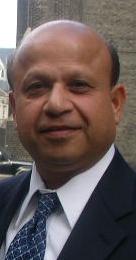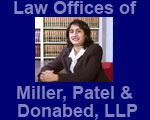Contribute
| Lokvani Talks To Dr. Kaplesh Kumar |
Ranjai Saigal
02/09/2005
Dr. Kaplesh Kumar discovered the nonequilibrium rare earth-transition metal (RETM) alloys that are the key enabling technology of the Nickel Metal Hydride (NiMH) battery, which has been recognized as one of the top 25 inventions of the past quarter-century by CNN. Dr. Kaplesh Kumar, Task Leader at Draper Laboratory received his B. Tech from IIT Kanpur and his Sc.D. from MIT. Later he received his J.D. from the New England School of Law. He has been admitted to the Bars of Massachusetts, United States Supreme Court, United States District Court for the First District, and the United States Patent and Trademark Office. He has numerous publications and patents to his credit, including a widely cited Applied Physics Reviews monograph on rare earth-transition metal (RETM) permanent magnets. He is an editorial committee member for the journal "International Materials Reviews". He is a very active member of the Indian American community in the Boston area. He has held the presidency of various organizations including MIT Sangam, the India Association of Greater Boston and the Indian American Forum for Political Education. He was also the founding Vice President-Kanpur of IITSINE. It is exciting to hear that the Nickel Metal Hydride Battery has been chosen as one of the top twenty-five inventions of the past quarter-century. Your work on RETM alloys is an important aspect of this invention. Could you describe the work on RETM alloys? In the 70s, I was working on high strength RETM permanent magnets, which had been discovered in the late 60s. These magnets have enabled the design of many unique devices, including small motors. Despite the strong promise, initial efforts worldwide failed to produce a high strength magnet, because of its poor resistance to demagnetization. Attempts to improve this resistance were largely unsuccessful. A group at Phillips Laboratories, Netherlands tried chemical etching of the alloy powder used as the precursor for fabricating the magnet. The idea was to remove any damaged surface layer. The acid exposure, instead, reduced the resistance further. This was traced to hydrogen absorption by the alloy. Thus, accidentally they had hit upon a good solution to store Hydrogen. Early efforts with this RETM alloy showed it was feasible to fabricate a NiMH battery. However, the RETM alloy produced by the conventional process (of alloy melting and slow cooling) disintegrated rapidly with hydrogen absorption and desorption, unacceptably limiting battery life. I overcame this limitation by rapidly quenching the molten RETM alloy, a process that I was investigating for RETM permanent magnets. I discovered that the rapidly quenched nonequilibrium RETM metal alloys had an even greater hydrogen storage capability than the conventional RETM alloy and also, more importantly, did not degrade from hydrogen absorption and desorption. Nonequilibrium RETM alloys are found in virtually all of today’s NiMH batteries, and comprises the key technology that renders the NiMH battery commercially viable. What are the major benefits of Nickel Metal Hydride Battery over its predecessor the Nickel Cadmium battery? While Ni-Cd battery uses the environmentally hazardous metal Cadmium, the NiMH battery uses the specially processed RETM which is environment friendly. These batteries have excellent recharge capacity. You may remember that in the past, if you recharged the battery without completely discharging it first, it would rapidly reduce the battery life to virtually nothing. That problem has been now been solved with the NiMH battery, which can be recharged at any time. These batteries have also enabled the creation of the Electric and Hybrid cars which are a lot less dependent on fossil fuel and, therefore, less polluting. Despite your passion for technology you went to law school to get a degree in law. What motivated you to do that? As an inventor, I was superficially familiar with the patent application process. My understanding of the law, however, was rudimentary, at best. My attorneys told me to attend law school if I wanted a proper understanding of patent rights. I am glad I did. It has already helped me, way beyond my initial expectations. I recently argued and won a "pro se" appeal in a NiMH battery patent infringement case before the United States Court of Appeals for the Federal Circuit, in Washington D.C. It was a wonderful and unique experience, one that few lawyers chance upon in their entire careers. The Court’s opinion has seen good legal press and citation, including as required reading for a patent litigation course at a prominent law school. Despite pursuing a very busy agenda at Draper Labs, you have given your time to many community organizations. You were responsible for the revival of the India Association of Greater Boston. Why did you give so much of your time to this cause? The India Association of Greater Boston (IAGB) is a very important organization since it is one of the few organizations that bring Indian Americans together. In the sixties and seventies, IAGB was a very active organization. As time passed, the community grew large and diverse, and people started forming groups whose focus was rather narrowly defined. New organizations began to form. Some were religious, others regional. Slowly, the support for IAGB eroded and in the nineties it had become a dead organization. When I took charge as President, many were telling me that I am wasting my time for they did not see the need for an all-Indian organization. I felt then as I do now that so far as our children are concerned the only identity they know is that of being Indian, and hence organizations like IAGB are the only organizations that will be relevant for a long time to come. So I decided to do my best to revive the organization. In the beginning it was a struggle. We worked hard to get the message about the organization out to the community. Harish Dang, with his radio program, Sounds of India, helped us tremendously. During my tenure, we celebrated the fiftieth anniversary of India’s Independence on a grand scale at the Hatch Shell. I think IAGB has not looked back since then, and I am glad to see its popularity continue to grow. It has a good message, and the message has reached the community at large. Subsequent committees have done a great job in growing this organization and institutionalizing its activities. You were a founding member of IITSINE. What motivated you to create this organization? IIT alumni had long felt a need to have an organization which could help them connect with their alma mater, while providing an opportunity for IIT alumni in New England to meet and share their talents with the community. Several of us came together to make this happen with Puran Dang as the Founding President. Originally, alumni from different IITs limited their interactions to small groups of individuals whom they knew. We felt it made more sense to form one large group since all IITians have a lot in common, and IITs in New England (IITSINE) was formed. IITians are very passionate about technology, and perhaps through IITSINE we can create a mentorship program to share our passion for engineering with the younger generation. This will be a valuable service to the engineering community and to the community at large. You were also president of the Indian American Forum for Political Education. What do you think is the value of this organization? I think it is essential for Indian Americans to be intimately involved in the American political process. We must actively engage in all aspects of the political process – be it supporting candidates or running for office ourselves. We must encourage and provide active support to Indian Americans running for office, so more members of our community become decision makers in city, state, and federal government. Forum is an organization that tries to achieve this goal. It has made some progress, but, I think, as the younger generation takes over this organization, it may really go far and accomplish a lot. As I listen to you describe all your efforts in the community, I sense an underlying theme of uniting people and working together. Is this the basis for all your work? Absolutely. I firmly believe that the more we come together the more we can accomplish. Based on your involvement in many organizations, what do you think leaders of organizations should do to ensure success? I think the goal should be to get a lot of people excited about the idea of the organization. Then you should have a core group that is willing to work hard to achieve the goal. If you have these two, you can build successful organizations. Thanks so much for your time. Thank you.
He spoke to Lokvani about his work and his contributions to the community.
While I understand the need for individual groups catering to specific needs, I think the need for coming together as Indian Americans is growing, and this need is felt strongly particularly among the younger generations. I think organizations that enable this coming together will have a significant role to play in the future.
You may also access this article through our web-site http://www.lokvani.com/

